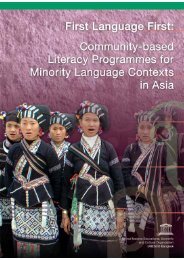Part II.pdf - MTB-MLE Network
Part II.pdf - MTB-MLE Network
Part II.pdf - MTB-MLE Network
You also want an ePaper? Increase the reach of your titles
YUMPU automatically turns print PDFs into web optimized ePapers that Google loves.
Background information on the project site including minority groups<br />
The project began by conducting a survey of the Omkoi target area. The project staff from the<br />
central office of ONFEC, as well as staff of provincial and district NFE centres and concerned<br />
agencies, were involved in the analysis survey of the site during 13-14 January 2003. The survey<br />
was done in 2 villages: Pa Kha village and Nong Ung Tai village. The former is 25 kilometres<br />
from the centre of Omkoi District, while the latter is 37 km away. It took 1 1 /2 hours to travel from<br />
Omkoi to Pa Kha village. Pa Kha village has a population of 226 persons living together in<br />
43 households. The people are Christian, using local Skor Karen language, and they already have<br />
a writing system.<br />
In Nong Ung Tai village, there are 270 village members living together in 70 families (58 households).<br />
Most of the people are animist or Buddhist. They speak the Pwo Karen language, which does not<br />
have a writing system. It took 2 hours from the centre of Omkoi to reach Nong Ung Tai, or<br />
4 hours from Chiang Mai. In the rainy season, the village cannot be reached. Nong Ung Tai village<br />
was selected to be the target site with the agreement of the NFE team. It would be a challenging<br />
pilot programme for the development of a bilingual approach to literacy.<br />
This village was established 200 years ago. At<br />
that time, there were only 10 households. At<br />
present, most people work in agriculture. They<br />
grow rice and some vegetables such as green<br />
cabbage, pumpkin, chillies and long beans.<br />
Chicken, cows, buffaloes and pigs are raised<br />
for meat. The average income is 2,500 baht/<br />
family/year (US $625). The Pwo Karen in this<br />
village are peaceful.<br />
The Community Learning Centre (CLC) is<br />
where the children receive their education.<br />
This CLC was begun in 1993 with the cooperation of the community, who constructed the building.<br />
Originally, it was a small bamboo shelter but, in 1998, it was reconstructed using wood. In 2001,<br />
with financial support from Her Royal Princess Maha Chakri Sirindhorn, the CLC was enlarged to<br />
6 metres wide in order to serve a hundred children. Normally, there are 2 NFE teachers, with one<br />
volunteer teacher serving as a supervisor. When the bilingual project started in January 2003, one<br />
more Pwo Karen teacher was added to work on the project at the village site.<br />
Needs assessment/community mobilization/Identification of learning needs<br />
This bilingual project is run in a different way to previous literacy programmes. The Karen CLC<br />
teachers are active participants in the project, not just recipients. As they work at village level,<br />
they know the needs and living conditions of the community. The project designed a set of<br />
questionnaires for the teachers to survey local needs and compile community data to indicate potential<br />
project entry points.<br />
205
















